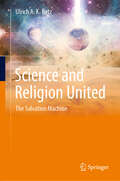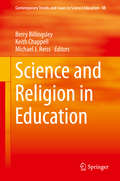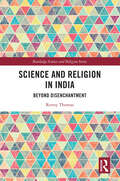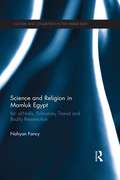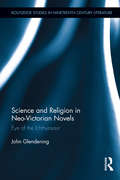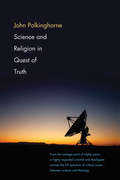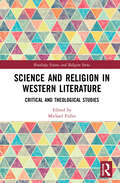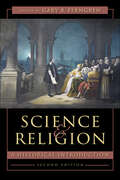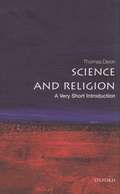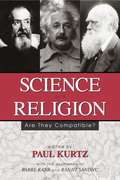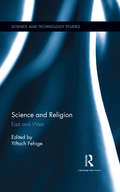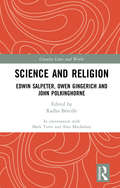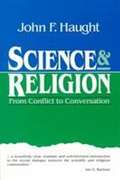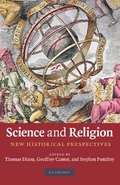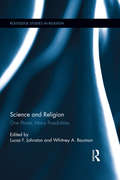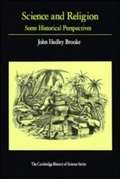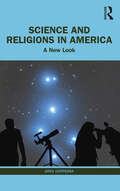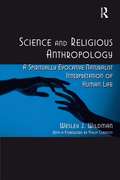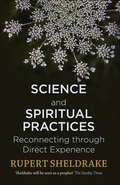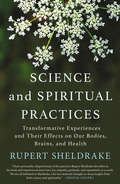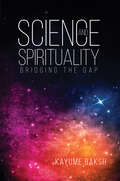- Table View
- List View
Science and Religion United: The Salvation Machine
by Ulrich A. BetzThis book offers a fresh perspective on how science and religion are connected, and how prayer aligns with the laws of nature. It explores a holistic worldview where science and religion complement each other, shedding light on life, society, and philosophical and societal concerns. We are born into a world full of mysteries that we only partially understand. We don’t know where we are coming from, we don’t know why we live, and we don’t know where we will go. We don’t know how everything started; we even don’t know what “everything” really is. We are living in an era of rapid change marked by disruptive technologies, like artificial intelligence and computers. Combined with a perception that the old wisdom transferred to us by religion is outdated, traditional values and institutions that had worth and power over many centuries are now losing their appeal. Science has made remarkable progress but can't answer life's most profound questions about our origins, purpose, and destination – why do we live and what should we do? In this book, the author begins with an overview of science, our understanding of the universe, highlighting gaps in our knowledge, like what started the Big Bang, followed by examples of successful scientific achievements and insights into the limits of science. In the subsequent chapters, the author examines topics such as mind over matter and the coexistence of evolution, creation, natural laws, and miracles. An attempt to answer the theodicy question is also provided in this book, where the author connects new scientific discoveries with ancient religious wisdom. The book concludes with a chapter devoted to innovation and a call for building a better world. This book is a compelling read for scholars, professionals, and curious laymen alike, ready to expand their horizons.
Science and Religion in Education (Contemporary Trends and Issues in Science Education #48)
by Michael J. Reiss Berry Billingsley Keith ChappellThis book brings together the latest research in education in relation to science and religion. Leading international scholars and practitioners provide vital insights into the underlying debates and present a range of practical approaches for teaching. Key themes include the origin of the universe, the theory of evolution, the nature of the human person, the nature of science and Artificial Intelligence. These are explored in a range of international contexts. The book provides a valuable resource for teachers, students and researchers in the fields of education, science, religious education and the growing specialist field of science and religion.Science and Religion in Education is a compelling read for current and future generations of academic researchers and teachers who wish to explore the fascinating intersect between science education and religious studies. The research findings and insights presented by these international scholars offer new dimensions on contemporary practice. - Vaille Dawson, Professor of Science Education, University of Western AustraliaScience and Religion in Education offers a fascinating and diverse collection of chapters surveying the current state of thinking about how science and religion can be understood in education. The book offers a wealth of thought-provoking material for anyone interested in the natures of science and religion, their relationship(s), or their representation within the curriculum. - Professor Keith Taber, University of CambridgeScience education and religious education are uncomfortable bedfellows. This book, written in part as a response to the – perhaps too clear – accounts of Ian Barbour, provides suitably nuanced pictures of how science and religion are dealt with in schools. Whatever the views of specialists, young people ‘receive’ an education in both science and religion: hearing their voices is refreshing in such a serious academic account. - Julian Stern, Professor of Education and Religion, York St John UniversityHumans have long endeavored to make sense of the world often using science and religion. Yet, these two great traditions are frequently seen as incompatible. This useful volume features thoughtful contributions from experts whose work straddles the divide and provides educators with arguments, engaging strategies and historical perspectives to help build a bridge and allow a fruitful discussion in schools. - William F. McComas, Distinguished Professor of Science Education, University of ArkansasEqual parts critical examination of existing models for the relationship between science and religion, scholarly exposition of newer models, and insights toward practical application in classrooms, this book is an invaluable resource for science and religion educators. If you have been thinking it is time we looked beyond Barbour’s taxonomy, you will want to read this book. If you have not, I implore you to read this book. - Jason Wiles, Associate Professor of Biology and Science Education, Syracuse University
Science and Religion in India: Beyond Disenchantment (Routledge Science and Religion Series)
by Renny ThomasThis book provides an in-depth ethnographic study of science and religion in the context of South Asia, giving voice to Indian scientists and shedding valuable light on their engagement with religion. Drawing on biographical, autobiographical, historical, and ethnographic material, the volume focuses on scientists’ religious life and practices, and the variety of ways in which they express them. Renny Thomas challenges the idea that science and religion in India are naturally connected and argues that the discussion has to go beyond binary models of ‘conflict’ and ‘complementarity’. By complicating the understanding of science and religion in India, the book engages with new ways of looking at these categories.
Science and Religion in Mamluk Egypt: Ibn al-Nafis, Pulmonary Transit and Bodily Resurrection (Culture and Civilization in the Middle East)
by Nahyan FancyThe discovery of the pulmonary transit of blood was a ground-breaking discovery in the history of the life sciences, and a prerequisite for William Harvey’s fully developed theory of blood circulation three centuries later. This book is the first attempt at understanding Ibn al-Nafīs’s anatomical discovery from within the medical and theological works of this thirteenth century physician-jurist, and his broader social, religious and intellectual contexts. Although Ibn al-Nafīs did not posit a theory of blood circulation, he nevertheless challenged the reigning Galenic and Avicennian physiological theories, and the then prevailing anatomical understandings of the heart. Far from being a happy guess, Ibn al-Nafīs’s anatomical result is rooted in an extensive re-evaluation of the reigning medical theories. Moreover, this book shows that Ibn al-Nafīs’s re-evaluation is itself a result of his engagement with post-Avicennian debates on the relationship between reason and revelation, and the rationality of traditionalist beliefs, such as bodily resurrection. Breaking new ground by showing how medicine, philosophy and theology were intertwined in the intellectual fabric of pre-modern Islamic societies, Science and Religion in Mamluk Egypt will be of interest to students and scholars of the History of Science, the History of Medicine and Islamic Studies.
Science and Religion in Neo-Victorian Novels: Eye of the Ichthyosaur (Routledge Studies in Nineteenth Century Literature)
by John GlendeningCriticism about the neo-Victorian novel — a genre of historical fiction that re-imagines aspects of the Victorian world from present-day perspectives — has expanded rapidly in the last fifteen years but given little attention to the engagement between science and religion. Of great interest to Victorians, this subject often appears in neo-Victorian novels including those by such well-known authors as John Fowles, A. S. Byatt, Graham Swift, and Mathew Kneale. This book discusses novels in which nineteenth-century science, including geology, paleontology, and evolutionary theory, interacts with religion through accommodations, conflicts, and crises of faith. In general, these texts abandon conventional religion but retain the ethical connectedness and celebration of life associated with spirituality at its best. Registering the growth of nineteenth-century secularism and drawing on aspects of the romantic tradition and ecological thinking, they honor the natural world without imagining that it exists for humans or functions in reference to human values. In particular, they enact a form of wonderment: the capacity of the mind to make sense of, creatively adapt, and enjoy the world out of which it has evolved — in short, to endow it with meaning. Protagonists who come to experience reality in this expansive way release themselves from self-anxiety and alienation. In this book, Glendening shows how, by intermixing past and present, fact and fiction, neo-Victorian narratives, with a few instructive exceptions, manifest this pattern.
Science and Religion in Quest of Truth
by John PolkinghorneJohn Polkinghorne, an international figure known both for his contributions to the field of theoretical elementary particle physics and for his work as a theologian, has over the years filled a bookshelf with writings devoted to specific topics in science and religion. In this new book, he undertakes for the first time a survey of all the major issues at the intersection of science and religion, concentrating on what he considers the essential insights for each. Clearly and without assuming prior knowledge, he addresses causality, cosmology, evolution, consciousness, natural theology, divine providence, revelation, and scripture. Each chapter also provides references to his other books in which more detailed treatments of specific issues can be found. For those who are new to what Polkinghorne calls "one of the most significant interdisciplinary interactions of our time," this volume serves as an excellent introduction. For readers already familiar with John Polkinghorne's books, this latest is a welcome reminder of the breadth of his thought and the subtlety of his approach in the quest for truthful understanding.
Science and Religion in Western Literature: Critical and Theological Studies (Routledge Science and Religion Series)
by Michael FullerThis book explores ways in which Western literature has engaged with themes found within the field of science and religion, both historically and in the present day. It focuses on works of the imagination as important locations at which human arguments, hopes and fears may be played out. The chapters examine a variety of instances where scientific and religious ideas are engaged by novelists, poets and dramatists, casting new light upon those ideas and suggesting constructive ways in which science and religion may interact. The contributors cover a rich variety of authors, including Mary Shelley, Aldous Huxley, R. S. Thomas, Philip Pullman and Margaret Atwood. Together they form a fascinating set of reflections on some of the significant issues encountered within the discourse of science and religion, indicating ways in which the insights of creative artists can make a valuable and important contribution to that discourse.
Science and Religion: A Historical Introduction
by Gary B. FerngrenAn essential examination of the historical relationship between science and religion.Since its publication in 2002, Science and Religion has proven to be a widely admired survey of the complex relationship of Western religious traditions to science from the beginning of the Christian era to the late twentieth century. In the second edition, eleven new essays expand the scope and enhance the analysis of this enduringly popular book.Tracing the rise of science from its birth in the medieval West through the scientific revolution, the contributors here assess historical changes in scientific understanding brought about by transformations in physics, anthropology, and the neurosciences and major shifts marked by the discoveries of Copernicus, Galileo, Isaac Newton, Charles Darwin, and others. In seeking to appreciate the intersection of scientific discovery and the responses of religious groups, contributors also explore the theological implications of contemporary science and evaluate approaches such as the Bible in science and the modern synthesis in evolution, which are at the center of debates in the historiography, understanding, and application of science.The second edition provides chapters that have been revised to reflect current scholarship along with new chapters that bring fresh perspectives on a diverse range of topics, including new scientific approaches and disciplines and non-Christian traditions such as Judaism, Islam, Asiatic religions, and atheism. This indispensible classroom guide is now more useful than ever before.Contributors: Richard J. Blackwell, Peter J. Bowler, John Hedley Brooke, Glen M. Cooper, Edward B. Davis, Alnoor Dhanani, Diarmid A. Finnegan, Noah Efron, Owen Gingerich, Edward Grant, Steven J. Harris, Matthew S. Hedstrom, John Henry, Peter M. Hess, Edward J. Larsen, Timothy Larson, David C. Lindberg, David N. Livingstone, Craig Martin, Craig Sean McConnell, James Moore, Joshua M. Moritz, Mark A. Noll, Ronald L. Numbers, Richard Olson, Christopher M. Rios, Nicolaas A. Rupke, Michael H. Shank, Stephen David Snobelen, John Stenhouse, Peter J. Susalla, Mariusz Tabaczek, Alan C. Weissenbacher, Stephen P. Weldon, and Tomoko Yoshida
Science and Religion: A Very Short Introduction
by Thomas DixonThe debate between science and religion is never out of the news: emotions run high, fueled by polemical bestsellers like The God Delusion and, at the other end of the spectrum, high-profile campaigns to teach "Intelligent Design" in schools. Yet there is much more to the debate than the clash of these extremes. As Thomas Dixon shows in this balanced and thought-provoking introduction, a whole range of views, subtle arguments, and fascinating perspectives can be found on this complex and centuries-old subject. He explores the key philosophical questions that underlie the debate, but also highlights the social, political, and ethical contexts that have made the tensions between science and religion such a fraught and interesting topic in the modern world. Dixon emphasizes how the modern conflict between evolution and creationism is quintessentially an American phenomenon, arising from the culture and history of the United States, as exemplified through the ongoing debates about how to interpret the First-Amendment's separation of church and state. Along the way, he examines landmark historical episodes such as the Galileo affair, Charles Darwin's own religious and scientific odyssey, the Scopes "Monkey Trial" in Tennessee in 1925, and the Dover Area School Board case of 2005, and includes perspectives from non-Christian religions and examples from across the physical, biological, and social sciences.
Science and Religion: An Introduction for Youth
by Holmes Rolston IIIThis is written for young people, grades 9-12, to read on their own, with others their age, as well as with parents and teachers.How is the scientific method similar to and different from the way that Christians think? One tends to see what one is looking for. Those who think about religion also use such frameworks. They may call them creeds. Both science and religion open up "big questions." Scientists seek causes; believers seek meanings.The origin and creation of the universe displays some surprising features. Physicists have found dramatic connections between astronomical and atomic scales that combine to make the Earth and its life possible. The mid-range scales where the most complex things are found depend on the interacting microscopic and astronomical ranges. The universe is "user-friendly."Scientific concepts of the origin of life are very different from the Genesis creation stories. Genetics is about creating, storing, elaborating information. The Genesis stories are a parable that reveals the meaning of creation. Biological science does discover a wonderland Earth. The Genesis parable affirms a land of promise, today an Earth with promise.The human mind is the most complex thing in the known universe. How much science of persons can psychologists have? Neuroscience has discovered remarkably plastic, flexible minds. Resolute behavior, especially in youth, re-shapes our minds. Humans have huge cognitive power gained by speech and language. Jesus teaches us to love God and neighbor. The two great commandments are not the facts of any science.The knowledge and wisdom of past and present transmitted to the future in cultures is as important as what we inherit genetically. How are youth shaped by their rearing, by their peer groups? How do people behave socially in groups: government, politics, churches, economics, and business? Also, evaluating ethical responsibilities for love and justice demands religious and philosophical judgments.Contemporary scientists have added a new science. What of artificial intelligence, of massive computing power? This aids science, makes possible new discoveries. Youth have pages on Facebook. They twitter. How will this behavior affect their adult character? Youth hear a lot about STEM - science, technology, engineering, math. Youth need faith and ethics to evaluate the values in STEM.Natural and cultural histories require searching for meanings. History is more narrative, the stories of personal life that shape history: Abraham, Muhammad, Jesus, Martin Luther, Martin Luther King, Israel, England, America, and the Second World War Youth today will write the history of this first century of the new millennium, with challenges as painful as ever. To do that with justice and love, they need the wisdom of the Christian faith. XX
Science and Religion: Approaches from Science and Technology Studies
by Zara Thokozani KamwendoThis edited volume offers new and exciting perspectives on the social study of science and religion through current scholarship grounded in Science and Technology Studies (STS). The contributors explore how STS theories, methods, and concepts can be applied to the study of religion, as well as how to incorporate aspects of religion into STS. The purpose of the volume is to advance the social study of science and religion by fostering the already interdisciplinary nature of the field and to encourage engagement with the intersection between science and religion from a wide range of perspectives.
Science and Religion: Are They Compatible?
by Paul Kurtz Contribution by Barry Karr Ranjit SandhuIn recent years a noticeable trend toward harmonizing the distinct worldviews of science and religion has become increasingly popular. Despite marked public interest, many leading scientists remain skeptical that there is much common ground between scientific knowledge and religious belief. Indeed, they are often antagonistic. Can an accommodation be reached after centuries of conflict? <P><P> In this stimulating collection of articles on the subject, Paul Kurtz, with the assistance of Barry Karr and Ranjit Sandhu, have assembled the thoughts of scientists from various disciplines. Among the distinguished contributors are Sir Arthur C. Clarke (author of 2001: A Space Odyssey, and numerous other works of science fiction); Nobel Prize Laureate Steven Weinberg (professor of physics at the University of Texas at Austin); Neil deGrasse Tyson (Princeton University astrophysicist and director of the Hayden Planetarium); James Lovelock (creator of the Gaia hypothesis); Kendrick Frazier (editor of the Skeptical Inquirer); Steven Pinker (professor of psychology at MIT); Richard Dawkins (zoologist at Oxford University); Eugenie Scott (physical anthropologist and executive director of the National Center for Science Education); Owen Gingerich (professor of astronomy at Harvard University); Martin Gardner (prolific popular science writer); the late Richard Feynman (Nobel Prize-winning physicist) and Stephen Jay Gould (professor of geology at Harvard University); and many other eminent scientists and scholars. <P><P> Among the topics discussed are the Big Bang and the origin of the universe, intelligent design and creationism versus evolution, the nature of the "soul," near-death experiences, communication with the dead, why people do or do not believe in God, and the relationship between religion and ethics.
Science and Religion: East and West (Science and Technology Studies)
by Yiftach FehigeThis volume situates itself within the context of the rapidly growing interdisciplinary field that is dedicated to the study of the complex interactions between science and religion. It presents an innovative approach insofar as it addresses the Eurocentrism that is still prevalent in this field. At the same time it reveals how science develops in the space that emerges between the ‘local’ and the ‘global’. The volume examines a range of themes central to the interaction between science and religion: ‘Eastern’ thought within ‘Western’ science and religion and vice versa, and revisits thinkers who sought to integrate ‘Eastern’ and ‘Western’ thinking. It studies Zen Buddhism and its relation to psychotherapy, Islamic science, Vedantic science, atheism in India, and Darwinism, offering in turn new perspectives on a variety of approaches to nature. Part of the Science and Technology Studies series, this volume brings together original perspectives from major scholars from across disciplines and will be of great interest to scholars and students of science and technology studies, history of science, philosophy of science, religious studies, and sociology.
Science and Religion: Edwin Salpeter, Owen Gingerich and John Polkinghorne (Creative Lives and Works)
by Alan Macfarlane Mark TurinScience and Religion: Edwin Salpeter, Owen Gingerich and John Polkinghorne is a collection of interviews being published as a book. These interviews have been conducted by one of England’s leading social anthropologists and historians, Professor Alan Macfarlane. Filmed over a period of 40 years, the five conversations in this volume, are part of Social Science Press’s series Creative Lives and Works. These transcriptions also form a part of a larger set of interviews that cut across various disciplines, from the social sciences, the sciences and to the performing and visual arts. The current volume is on three foremost physicists and historians of science. Edwin Salpeter recounts rather dispassionately his departure from Austria to Australia to escape Nazi persecution. And in doing so broaches, not only, on the prevailing anti-Semitic sentiment of the time, but takes the debate forward into the one between science and religion. Though he only touches upon it, this debate finds resonance in the words of Owen Gingerich who belonged to the Mennonite dispensation and who has been rather vocal about the pro-Christian anti-creationist ideology. However, it is John Polkinghorne who provides a deep insight into the ongoing debate on science and religion. Immensely riveting as conversations, this collection reveals how intrinsically related science and religion are, how pertinent it is to understand the workings of science in the context of religion. The book will be of enormous value not just to those interested in Astronomy and Cosmology as well as the History of Science, but also to those with an inquisitive mind. Please note: This title is co-published with Social Science Press, New Delhi. Taylor & Francis does not sell or distribute the Hardback in India, Pakistan, Nepal, Bhutan, Bangladesh and Sri Lanka.
Science and Religion: From Conflict to Conversation
by John F. HaughtA guide to dialogue between scientists and believers.
Science and Religion: New Historical Perspectives
by Thomas Dixon Geoffrey Cantor Stephen PumfreyThe debate between science and religion is never out of the news: emotions run high, fuelled by polemical bestsellers like The God Delusion and, at the other end of the spectrum, high-profile campaigns to teach "Intelligent Design" in schools. Yet there is much more to the debate than the clash of these extremes. As Thomas Dixon shows in this balanced and thought-provoking introduction, a whole range of views, subtle arguments, and fascinating perspectives can be found on this complex and centuries-old subject. He explores the key philosophical questions that underlie the debate, but also highlights the social, political, and ethical contexts that have made the tensions between science and religion such a fraught and interesting topic in the modern world. Dixon emphasizes how the modern conflict between evolution and creationism is quintessentially an American phenomenon, arising from the culture and history of the United States, as exemplified through the ongoing debates about how to interpret the First-Amendment's separation of church and state. Along the way, he examines landmark historical episodes such as the Galileo affair, Charles Darwin's own religious and scientific odyssey, the Scopes "Monkey Trial" in Tennessee in 1925, and the Dover Area School Board case of 2005, and includes perspectives from non-Christian religions and examples from across the physical, biological, and social sciences.
Science and Religion: One Planet, Many Possibilities (Routledge Studies in Religion)
by Whitney A. Bauman Lucas F. JohnstonThis collection offers new perspectives on the study of science and religion, bringing together articles that highlight the differences between epistemological systems and call into question the dominant narrative of modern science. The volume provides historical context for the contemporary discourse around religion and science, detailing the emergence of modern science from earlier movements related to magic and other esoteric arts, the impact of the Reformation on science, and the dependence of Western science on the so-called Golden Age of Islam. In addition, contributors examine the impacts of Western science and colonialism on the ongoing theft of the biological resources of traditional and indigenous communities in the name of science and medicine. The volume’s multi-perspectival approach aims to refocus the terms of the conversation around science and religion, taking into consideration multiple rationalities outside of the dominant discourse.
Science and Religion: Some Historical Perspectives
by John Hedley BrookeOne of the most fascinating and enduring issues in the development of the modern world is the relationship between scientific thought and religious belief. It is common knowledge that in Western societies there have been periods of crisis when new science has threatened established religious authority. The trial of Galileo in 1633 and the uproar caused by Darwin's Origin of Species(1859) are two famous examples. Taking account of recent scholarship in the history of science, Professor Brooke takes a fresh look at these and similar episodes, showing that science and religion have been mutually relevant in such a rich variety of ways that simple generalizations are not possible. Standing back from general theses affirming "conflict" or "harmony," which have so often served partisan interests, the author's object is to reveal the subtlety, complexity, and diversity of the interaction of science and religion as it has taken place in the past and in the twentieth century. Instead of treating science and religion as discrete definable entities, his approach is sensitive to shifting boundaries and willing to consider the contexts in which particular forms of science could be used both for religious and secular ends. The result is that, without assuming specialist knowledge, Brooke provides a wide-ranging study from the Copernican innovation to in vitro fertilization.
Science and Religions in America: A New Look
by Greg CootsonaWhat is religion? What is science? How do they interact with each other? Science and Religions in America: A New Look offers a cutting-edge overview of the diverse range of religious traditions and their complex and fascinating interaction with science. Pluralistic in scope, the book is different from traditional Christian and/or monotheistic approaches to studying the rich interplay of religion and science in multi-religious American culture. Featuring interviews with specialists in the field, Greg Cootsona draws on their insights to provide a comprehensive, accessible, and engaging introduction to the challenging interrelationship of religion and science. Each chapter focuses on a different religion within the United States, covering Buddhism, Christianity, Nature Religions, Islam, Judaism, Hinduism, and the Spiritual but Not Religious (SBNR). Global religious traditions and their inextricable relationship with science and technology are examined in an accessible and interactive format. With "lightning round Q&As," contributions from leading thinkers, and suggestions for further reading, this book primes undergraduate students for studying the interchange of science and religions (in the plural) and is an exciting new resource for those interested in these topics in contemporary America.
Science and Religious Anthropology: A Spiritually Evocative Naturalist Interpretation of Human Life (Ashgate Science And Religion Ser.)
by Wesley J. WildmanScience and Religious Anthropology explores the convergence of the biological sciences, human sciences, and humanities around a spiritually evocative, naturalistic vision of human life. The disciplinary contributions are at different levels of complexity, from evolution of brains to existential longings, and from embodied sociality to ecosystem habitat. The resulting interpretation of the human condition supports some aspects of traditional theological thinking in the world's religious traditions while seriously challenging other aspects. Wesley Wildman draws out these implications for philosophical and religious anthropology and argues that the modern secular interpretation of humanity is most compatible with a religious form of naturalistic humanism. This book resists the reduction of meaning and value questions while taking scientific theories about human life with full seriousness. It argues for a religious interpretation of human beings as bodily creatures emerging within a natural environment that permits engagement with the valuational potentials of reality. This engagement promotes socially borne spiritual quests to realize and harmonize values in everything human beings do, from the forging of cultures to the crafting of personal convictions.
Science and Spiritual Practices: Reconnecting through direct experience
by Rupert SheldrakeIn this pioneering book Rupert Sheldrake shows how science helps validate seven practices on which all religions are built, and which are part of our common human heritage:· Meditation· Gratitude· Connecting with nature· Relating to plants· Rituals· Singing and chanting· Pilgrimage and holy places. The effects of spiritual practices are now being investigated scientifically as never before, and many studies have shown that religious and spiritual practices generally make people happier and healthier. Rupert Sheldrake summarizes the latest scientific research on what happens when we take part in these practices, and suggests ways that readers can explore these fields for themselves. For those who are religious, Science and Spiritual Practices will illuminate the evolutionary origins of their own traditions and give a new appreciation of their power. For the non-religious, this book will show how the core practices of spirituality are accessible to all, even if they do not subscribe to a religious belief system. This is a book for anyone who suspects that in the drive towards radical secularism, something valuable has been left behind. Rupert Sheldrake believes that by opening ourselves to the spiritual dimension we may find the strength to live more wholesome and fulfilling lives.
Science and Spiritual Practices: Reconnecting through direct experience
by Rupert SheldrakeIn this pioneering book Rupert Sheldrake shows how science helps validate seven practices on which all religions are built, and which are part of our common human heritage:· Meditation· Gratitude· Connecting with nature· Relating to plants· Rituals· Singing and chanting· Pilgrimage and holy places. The effects of spiritual practices are now being investigated scientifically as never before, and many studies have shown that religious and spiritual practices generally make people happier and healthier. Rupert Sheldrake summarizes the latest scientific research on what happens when we take part in these practices, and suggests ways that readers can explore these fields for themselves. For those who are religious, Science and Spiritual Practices will illuminate the evolutionary origins of their own traditions and give a new appreciation of their power. For the non-religious, this book will show how the core practices of spirituality are accessible to all, even if they do not subscribe to a religious belief system. This is a book for anyone who suspects that in the drive towards radical secularism, something valuable has been left behind. Rupert Sheldrake believes that by opening ourselves to the spiritual dimension we may find the strength to live more wholesome and fulfilling lives.
Science and Spiritual Practices: Reconnecting through direct experience
by Rupert SheldrakeIn this pioneering book Rupert Sheldrake shows how science helps validate seven practices on which all religions are built, and which are part of our common human heritage:· Meditation· Gratitude· Connecting with nature· Relating to plants· Rituals· Singing and chanting· Pilgrimage and holy places. The effects of spiritual practices are now being investigated scientifically as never before, and many studies have shown that religious and spiritual practices generally make people happier and healthier. Rupert Sheldrake summarizes the latest scientific research on what happens when we take part in these practices, and suggests ways that readers can explore these fields for themselves. For those who are religious, Science and Spiritual Practices will illuminate the evolutionary origins of their own traditions and give a new appreciation of their power. For the non-religious, this book will show how the core practices of spirituality are accessible to all, even if they do not subscribe to a religious belief system. This is a book for anyone who suspects that in the drive towards radical secularism, something valuable has been left behind. Rupert Sheldrake believes that by opening ourselves to the spiritual dimension we may find the strength to live more wholesome and fulfilling lives.
Science and Spiritual Practices: Transformative Experiences and Their Effects on Our Bodies, Brains, and Health
by Rupert Sheldrake"I have personally adopted many of the practices Rupert describes in his book and experienced more love, joy, empathy, gratitude, and equanimity as a result. We are all indebted to Rupert, who has tirelessly brought us deep insights from both science and spirituality.&” ―Deepak ChopraThe effects of spiritual practices are now being investigated scientifically as never before, and many studies have shown that religious and spiritual practices generally make people happier and healthier. In this pioneering book, Rupert Sheldrake shows how science helps validate seven practices on which many religions are built, and which are part of our common human heritage: meditation, gratitude, connecting with nature, relating to plants, rituals, singing and chanting, and pilgrimage and holy places.Sheldrake summarizes the latest scientific research on what happens when we take part in these practices, and suggests ways that readers can explore these fields for themselves. For those who are religious, Science and Spiritual Practices will illuminate the evolutionary origins of their own traditions and give a new appreciation of their power. For the nonreligious, this book will show how the core practices of spirituality are accessible to all.This is a book for anyone who suspects that in the drive toward radical secularism, something valuable has been left behind. Rupert Sheldrake compellingly argues that by opening ourselves to the spiritual dimension, we may find the strength to live more fulfilling lives.
Science and Spirituality
by Kayume BakshThis book provides a fascinating, well-researched, and thorough discussion of the connections between science and spirituality, including religion. It is eye-opening and allows readers to truly redefine how they look at these disciplines while providing, at the same time, a vibrant perspective for those embarking on such an exercise for the first time.Science investigates the physical world, where space, time, and matter comprise the main aspects of its empirical approach, that is, of physically proving all that there is around us. Spirituality goes beyond the physical. Here, physical quantities become non-existent and so our connections are perceived through seemingly nonrational (but hardly irrational) unscientific means. Religion is rendered useless as a way of explaining how the universe works. Quantum mechanics, an integral part of modern physics, is helping to bring about a closer convergence by showing remarkable similarities between advanced scientific observations and what has been taught for centuries in the wisdom traditions, known as spirituality. This insightful information continues to amaze us like none before.We, therefore, now have the right combination and evidence to show why the gap between science and spirituality must be bridged so that we can finally embrace the answers to mysterious questions about the universe and life. This thought-provoking book provides the details you need.We stand on the verge of heralding a new paradigm or, rather, a metaparadigm – the mother of all paradigms – one that unfolds a new vision of reality that includes consciousness for the first time, not excludes it – as science still does.Whether you belong to a religion or not, are a spiritualist, an atheist, an agnostic, or just curious about the universe and life, this book is for you.
